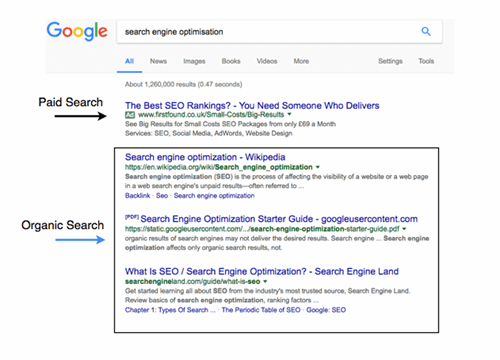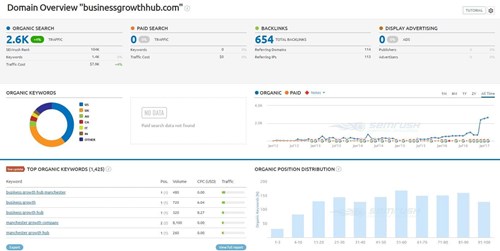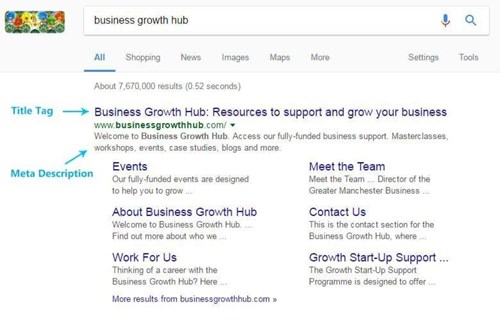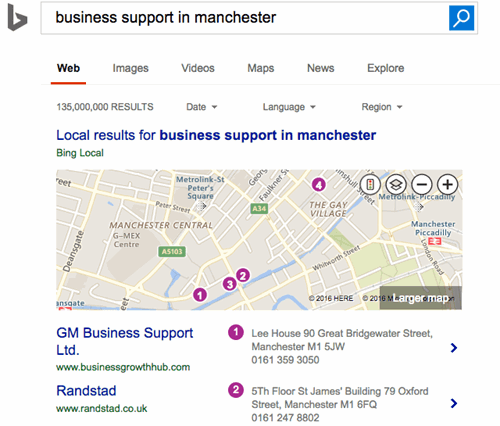Getting started with SEO
27 February 2017
We sat down with our digital advisor, Chris Murphy, to understand the fundamentals of SEO or Search Engine Optimisation and what businesses can do to improve their own.
So what exactly is SEO? In short, it is the process organisations can use to climb organic, as opposed to paid for, search engine rankings.
From the outset, it can appear a difficult process to understand, and one that’s layered in more than its fair share of jargon, but it’s also a process that is worth mastering within your business.
This simple guide focuses on some of the key SEO factors which can affect your ranking and sets out to demystify the process and give you the confidence to talk knowledgeably with SEO professionals, or even tackle SEO yourself.

So why bother with SEO?
Featuring on the first page of results from an organic search is essential in today’s time-poor society. Ask yourself, how many times do you click past the first page of results? Front page results can have a considerable impact on the volume of traffic going through to your website, with positive effects on both sales and, perhaps more surprisingly, trust in your brand, too.
A recent study showed the importance of positioning on Click Through Rates (CTR), with the first position yielding a 31% click-through rate, compared to just 1.5% for ninth place. You can use their handy tool yourself by clicking the image below.

So how do you improve your ranking?
On page SEO
There are a number of key metrics to consider with SEO, beginning with On Page SEO, which is the practice of optimising individual web pages through content and HTML code.
Keyword research
You should pick at least one primary keyword for each page. It’s worth doing some research first and the following are all useful resources to find indications on traffic volumes related to keywords:
However, less is more when it comes to keywords, and Google has now introduced an ‘over-optimisation penalty’ that targets website with too many keywords - and that can affect your ranking.
Site crawl test
What is a site crawler?
A website crawler, or spider, is an internet bot that searches the web for indexing purposes. A (slightly dated) video from Google explains this in detail and can be found here.
How do I run a Site Crawl Test?
Run a website audit using software such as MOZ or SEM Rush. This will determine your current website’s health and how you can optimise it for search, providing specific reasons and advice on areas to change. Below you can see an example of our own SEM rush search. You can see it highlights backlinks and their origin, keywords and much more.

Site speed
Check your website’s speed using a tool such as Google PageSpeed Insights This is a great way of finding out if you have any major issues that are hindering your website’s performance.
Webpage optimisation
Content - create unique and relevant content that is linkable. Do not create content that is generic and of little value to a user.
URL - ensure it is readable and where possible contains keywords. Here’s a brilliant infographic from MOZ that sums it up perfectly:
Title tag – this should be relevant to the content on the page and where possible include keywords at the front.
Meta Description –These is the 160 character description can have a considerable impact on your link’s click through rate. Although this does not have an impact on your search engine rankings it does impact on the click through rate of your link.
Image alt text – this should accurately and succinctly describe what the image is. You should also make sure this text has strong keywords too and this helps search engines when they are carrying out an image search (here’s a guide). It is also useful for people using non-graphical web browsers or for visually impaired using assistive devices.

Create an XML Sitemap
This is a listing of all of the URLs on your website that you want search engines to crawl and index. A sitemap should be submitted toGoogle through Google Webmaster Tools, or to Bing through Bing Webmaster Tools.
Create a Robots.TXT file
Remember those website crawlers we spoke of? Well, this is what tells crawlers how to crawl your website. It’s a complex topic so if you want to read more on it Bing ha written a great article explaining it in more detail.
Monitor Success
Do your website visitors spend time reading your pages? What does their user journey look like? If you haven’t already, I’d recommend installing Google Analytics to monitor ongoing success and to keep you informed about the keywords that people are using to find your site. Keep up to date by regularly checking Google Webmaster Tools and Bing Webmaster Tools.
Overview
Take a look at this comprehensive infographic put together by MOZ. It explains all you need to know when getting started with on-page optimisation.
So what should you avoid?
Ensure you don’t fill your page with a list of keywords and attempt to "cloak" pages, with content presented to search engines that is different to that shown to users. Instead make your content primarily for users, not for search engines. Essentially, search engines are designed to service their users the best way possible. Users are going to come to your site if it’s optimised to them, not to the crawler. It’s also worth bearing in mind that if your site contains pages, links, or text that you don't intend visitors to see, Google considers those links and pages deceptive and may ignore your site.
Consider reviewing Google’s Webmaster Guidelines for best practice.
Off page SEO
Off Page SEO is the process of optimising a website externally from the website code or design. The sort of processes involved here include:
Link Building
This refers to the process of getting external websites to link to a page on your website. The emphasis is on building high-quality relevant links and not pursuing mass numbers of low-quality links, so try using Website Authority Checker
As the Kissmetrics website explains - “If you think about ranking at the top of search results as a popularity contest, then links are like votes saying your website deserves to be ranked highly.”
Social Media
Although almost all of backlinks from Social Media are no-follow (a notice to search engines to not count the link), Social Media is still important for brand awareness and earning links. You can add value by utilising relevant shareable content on your website, such as Blogs, tutorials and how-to guides, which can help build real partnerships online and creates trust with your customers.
Local listings
What is a local listing?
A local listing is an online profile that contains your business details (name, address, phone number and any additional detail). There are a substantial amount of free business listings you can claim online and boost your profile.
So how do you check?
Check your local listings using Moz Local and ensure you have claimed your Google Places For Business Page and that all of your listing data matches up.

Next steps?
Now you’ve got a better understanding of SEO and its importance, it’s time to consider whether you or someone within your organisation, can set about optimising your website. Or perhaps you feel it’s a job best done by a specialist company.
Whichever route you choose, the Business Growth Hub can help so why not drop me an email chris.murphy@businessgrowthhub.com for more information.